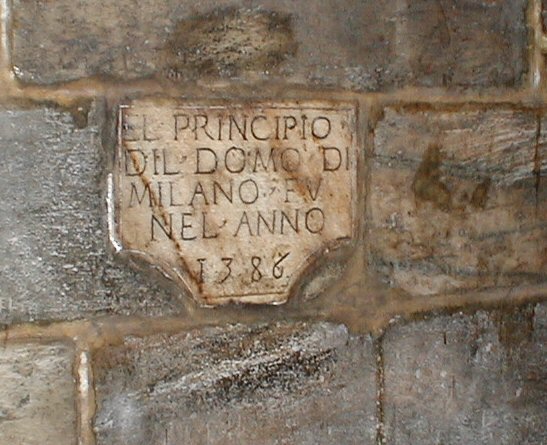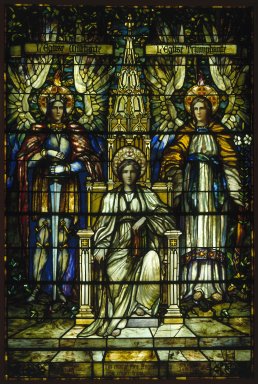|
St. John's Episcopal Church (Butte, Montana)
St. John's Episcopal Church is the oldest standing church in Butte, Montana. History and design The original building, St. John's Episcopal Church, is the oldest standing church in Butte, and one of the oldest in Montana. Faced in Butte granite, St. John's predates St. Patrick's Roman Catholic Church by one year. The church is closely connected to Copper King W.A. Clark, whose mansion is just a block north. The parish hall and basement gymnasium (now a class room and an office) were added in 1917. For three years after a 1918 fire gutted the interior, services were held in the parish hall, and not until 1931 was the stained-glass window behind the altar restored. That window was executed by Pompeo Bertini, stained-glass artist for the Cathedral of Milan, Italy, and is dedicated to Clark's daughter Jessie, who died at age 2 years, 11 months in 1878. The restoration of the window was paid for by Clark's son William A., Jr., and Jessie's twin sister, Catherine. Additional expansion ... [...More Info...] [...Related Items...] OR: [Wikipedia] [Google] [Baidu] |
Butte, Montana
Butte ( ) is a consolidated city-county and the county seat of Silver Bow County, Montana, United States. In 1977, the city and county governments consolidated to form the sole entity of Butte-Silver Bow. The city covers , and, according to the 2020 United States Census, 2020 census, has a population of 34,494, making it Montana's List of municipalities in Montana, fifth largest city. It is served by Bert Mooney Airport with airport code BTM. Established in 1864 as a mining camp in the northern Rocky Mountains on the Continental Divide of the Americas, Continental Divide, Butte experienced rapid development in the late-nineteenth century, and was Montana's first major industrial city. In its heyday between the late-nineteenth and early-twentieth centuries, it was one of the largest copper boomtowns in the American West. Employment opportunities in the mines attracted surges of Asian and European immigrants, particularly the Irish people, Irish; as of 2017, Butte has the largest ... [...More Info...] [...Related Items...] OR: [Wikipedia] [Google] [Baidu] |
William A
William is a male given name of Germanic origin.Hanks, Hardcastle and Hodges, ''Oxford Dictionary of First Names'', Oxford University Press, 2nd edition, , p. 276. It became very popular in the English language after the Norman conquest of England in 1066,All Things William"Meaning & Origin of the Name"/ref> and remained so throughout the Middle Ages and into the modern era. It is sometimes abbreviated "Wm." Shortened familiar versions in English include Will, Wills, Willy, Willie, Bill, and Billy. A common Irish form is Liam. Scottish diminutives include Wull, Willie or Wullie (as in Oor Wullie or the play ''Douglas''). Female forms are Willa, Willemina, Wilma and Wilhelmina. Etymology William is related to the given name ''Wilhelm'' (cf. Proto-Germanic ᚹᛁᛚᛃᚨᚺᛖᛚᛗᚨᛉ, ''*Wiljahelmaz'' > German ''Wilhelm'' and Old Norse ᚢᛁᛚᛋᛅᚼᛅᛚᛘᛅᛋ, ''Vilhjálmr''). By regular sound changes, the native, inherited English form of the name shoul ... [...More Info...] [...Related Items...] OR: [Wikipedia] [Google] [Baidu] |
Milan Cathedral
Milan Cathedral ( it, Duomo di Milano ; lmo, Domm de Milan ), or Metropolitan Cathedral-Basilica of the Nativity of Saint Mary ( it, Basilica cattedrale metropolitana di Santa Maria Nascente, links=no), is the cathedral church of Milan, Lombardy, Italy. Dedicated to the Nativity of St Mary (''Santa Maria Nascente''), it is the seat of the Archbishop of Milan, currently Archbishop Mario Delpini. The cathedral took nearly six centuries to complete: construction began in 1386, and the final details were completed in 1965. It is the largest church in the Italian Republic—the larger St. Peter's Basilica is in the State of Vatican City, a sovereign state—and possibly the second largest in Europe and the third largest in the world (its size and position remain a matter of debate). History Milan's layout, with streets either radiating from the Duomo or circling it, reveals that the Duomo occupies what was the most central site in Roman Mediolanum, that of the public bas ... [...More Info...] [...Related Items...] OR: [Wikipedia] [Google] [Baidu] |
William Andrews Clark, Jr
William is a male given name of Germanic origin.Hanks, Hardcastle and Hodges, ''Oxford Dictionary of First Names'', Oxford University Press, 2nd edition, , p. 276. It became very popular in the English language after the Norman conquest of England in 1066,All Things William"Meaning & Origin of the Name"/ref> and remained so throughout the Middle Ages and into the modern era. It is sometimes abbreviated "Wm." Shortened familiar versions in English include Will, Wills, Willy, Willie, Bill, and Billy. A common Irish form is Liam. Scottish diminutives include Wull, Willie or Wullie (as in Oor Wullie or the play ''Douglas''). Female forms are Willa, Willemina, Wilma and Wilhelmina. Etymology William is related to the given name ''Wilhelm'' (cf. Proto-Germanic ᚹᛁᛚᛃᚨᚺᛖᛚᛗᚨᛉ, ''*Wiljahelmaz'' > German ''Wilhelm'' and Old Norse ᚢᛁᛚᛋᛅᚼᛅᛚᛘᛅᛋ, ''Vilhjálmr''). By regular sound changes, the native, inherited English form of the name should b ... [...More Info...] [...Related Items...] OR: [Wikipedia] [Google] [Baidu] |
J&R Lamb Studios
J&R Lamb Studios, America's oldest continuously-run decorative arts company, is famous as a stained glass maker, preceding the studios of both John LaFarge and Louis C. Tiffany.Lamb Studios Archive - Library of Congress History The J&R Lamb Studios was established in 1857 by brothers Joseph (1833–1898) and Richard Lamb (1836–1909) in in . Their parents, Joseph Lamb (1806-1840) and Elizabeth Clark (1809-1838) were married on October 1, 1832, in Orpington, Kent, England. Elizabeth Clark Lamb died on April 7, 1838, during a diffic ...[...More Info...] [...Related Items...] OR: [Wikipedia] [Google] [Baidu] |
Pipe Organ
The pipe organ is a musical instrument that produces sound by driving pressurized air (called ''wind'') through the organ pipes selected from a keyboard. Because each pipe produces a single pitch, the pipes are provided in sets called ''ranks'', each of which has a common timbre and volume throughout the keyboard compass. Most organs have many ranks of pipes of differing timbre, pitch, and volume that the player can employ singly or in combination through the use of controls called stops. A pipe organ has one or more keyboards (called '' manuals'') played by the hands, and a pedal clavier played by the feet; each keyboard controls its own division, or group of stops. The keyboard(s), pedalboard, and stops are housed in the organ's ''console''. The organ's continuous supply of wind allows it to sustain notes for as long as the corresponding keys are pressed, unlike the piano and harpsichord whose sound begins to dissipate immediately after a key is depressed. The smallest po ... [...More Info...] [...Related Items...] OR: [Wikipedia] [Google] [Baidu] |
Crenellated
A battlement in defensive architecture, such as that of city walls or castles, comprises a parapet (i.e., a defensive low wall between chest-height and head-height), in which gaps or indentations, which are often rectangular, occur at intervals to allow for the launch of arrows or other projectiles from within the defences. These gaps are termed " crenels" (also known as ''carnels'', or ''embrasures''), and a wall or building with them is called crenellated; alternative (older) terms are castellated and embattled. The act of adding crenels to a previously unbroken parapet is termed crenellation. The function of battlements in war is to protect the defenders by giving them something to hide behind, from which they can pop out to launch their own missiles. A defensive building might be designed and built with battlements, or a manor house might be fortified by adding battlements, where no parapet previously existed, or cutting crenellations into its existing parapet wall. A d ... [...More Info...] [...Related Items...] OR: [Wikipedia] [Google] [Baidu] |
Norman Architecture
The term Norman architecture is used to categorise styles of Romanesque architecture developed by the Normans in the various lands under their dominion or influence in the 11th and 12th centuries. In particular the term is traditionally used for English Romanesque architecture. The Normans introduced large numbers of castles and fortifications including Norman keeps, and at the same time monasteries, abbeys, churches and cathedrals, in a style characterised by the usual Romanesque rounded arches (particularly over windows and doorways) and especially massive proportions compared to other regional variations of the style. Origins These Romanesque styles originated in Normandy and became widespread in northwestern Europe, particularly in England, which contributed considerable development and where the largest number of examples survived. At about the same time, a Norman dynasty that ruled in Sicily produced a distinctive variation–incorporating Byzantine and Saracen influen ... [...More Info...] [...Related Items...] OR: [Wikipedia] [Google] [Baidu] |
Episcopal Church (United States)
The Episcopal Church, based in the United States with additional dioceses elsewhere, is a member church of the worldwide Anglican Communion. It is a mainline Protestant denomination and is divided into nine provinces. The presiding bishop of the Episcopal Church is Michael Bruce Curry, the first African-American bishop to serve in that position. As of 2022, the Episcopal Church had 1,678,157 members, of whom the majority were in the United States. it was the nation's 14th largest denomination. Note: The number of members given here is the total number of baptized members in 2012 (cf. Baptized Members by Province and Diocese 2002–2013). Pew Research estimated that 1.2 percent of the adult population in the United States, or 3 million people, self-identify as mainline Episcopalians. The church has recorded a regular decline in membership and Sunday attendance since the 1960s, particularly in the Northeast and Upper Midwest. The church was organized after the Americ ... [...More Info...] [...Related Items...] OR: [Wikipedia] [Google] [Baidu] |
Buildings And Structures In Butte, Montana
A building, or edifice, is an enclosed structure with a roof and walls standing more or less permanently in one place, such as a house or factory (although there's also portable buildings). Buildings come in a variety of sizes, shapes, and functions, and have been adapted throughout history for a wide number of factors, from building materials available, to weather conditions, land prices, ground conditions, specific uses, prestige, and aesthetic reasons. To better understand the term ''building'' compare the list of nonbuilding structures. Buildings serve several societal needs – primarily as shelter from weather, security, living space, privacy, to store belongings, and to comfortably live and work. A building as a shelter represents a physical division of the human habitat (a place of comfort and safety) and the ''outside'' (a place that at times may be harsh and harmful). Ever since the first cave paintings, buildings have also become objects or canvasses of much artistic ... [...More Info...] [...Related Items...] OR: [Wikipedia] [Google] [Baidu] |
.jpg)



